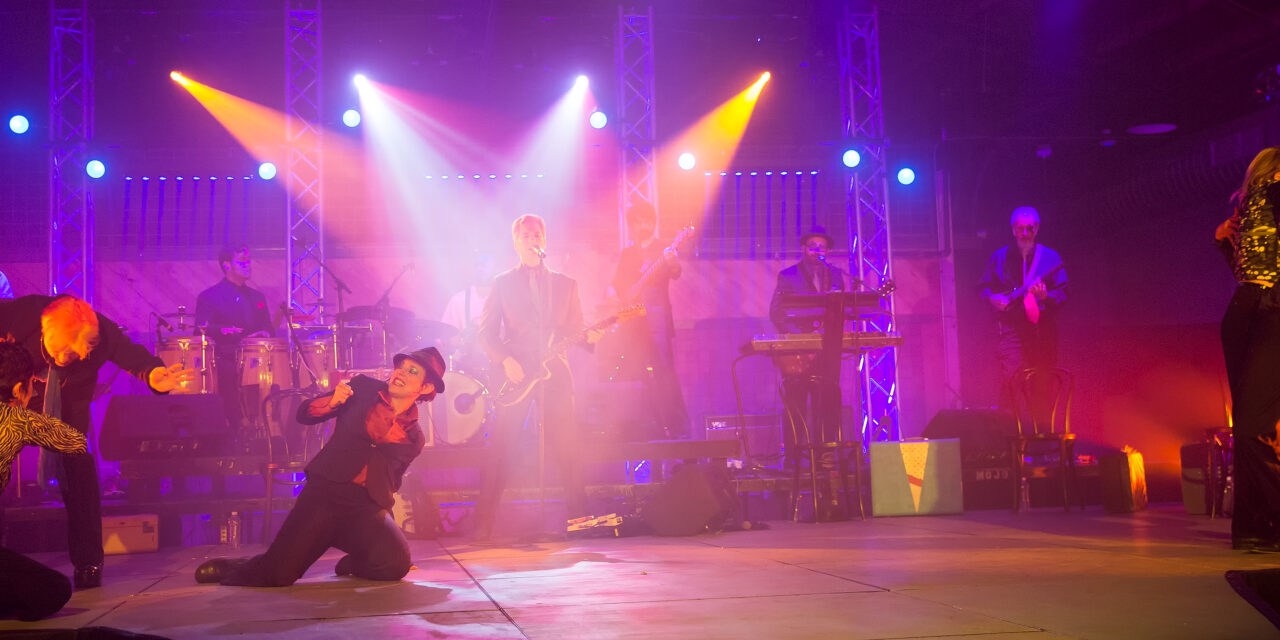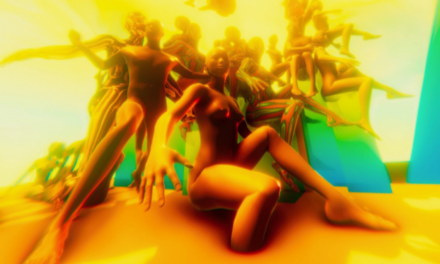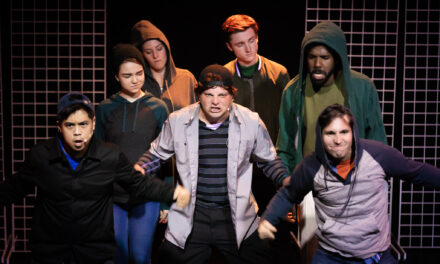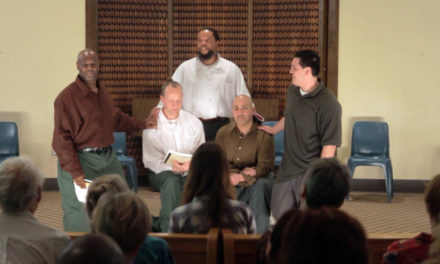Established in 1997 by Leese Walker, the Strike Anywhere Performance Ensemble is an interdisciplinary collective of world-class improvisers. The company creates provocative performances and innovative education programs that promote empathy, creativity, and civic discourse. Strike Anywhere’s work is guided by the words of Bertolt Brecht “Art is not a mirror held up to reality but a hammer with which to shape it.” SA performances always feature live music, physical theatre, and dance. Strike Anywhere is the preeminent theatre company in the United States practicing Soundpainting, a universal sign language developed by composer Walter Thompson for live composition with improvisers. Strike Anywhere has performed and taught in over 200 venues in 16 states and 8 countries.
Irina Yakubovskaya: What role in your opinion should an artistic community play today when the world is in turmoil?
Leese Walker: The world is in turmoil, yes, agreed! And yet the role of the artistic community remains the same. Our job is to respond to the world around us, to challenge assumptions, to investigate and overturn the status quo, to promote empathy, to spark dialogue, to inspire new perspectives and to question. I travel in many circles as an artist. I step into communities of extreme poverty and of extreme wealth, but on the rare occasion when it happens on the same day, that jarring effect allows me to see both worlds in high relief. Same with travel – I love to travel. Travel allows you to see your familiar world in a new way, to question why things are the way they are, and to clear space for new ideas. I think the role of the artistic community is similar . . . to question the world and provoke the public to explore new ideas.
I choose to work with an ensemble process. I find it to be the most satisfying way to work because it is inquiry-based, requires time, trust, and long-standing relationships and because it relies on many minds to problem-solve. I began Strike Anywhere in ’97, as a lab for experimentation with improvisation. My players have been with the ensemble for anywhere from 10 to 20 years. There is no substitution for that kind of time, of lived experience and play with one another. I passionately believe in this style of work because, for me, it is living the kind of change I want to see in the world: lateral power-sharing, a non-hierarchical process that values all voices. I suppose this is the other important role that the artistic community can play: embodying the values we espouse through our organizational practice and methodologies.
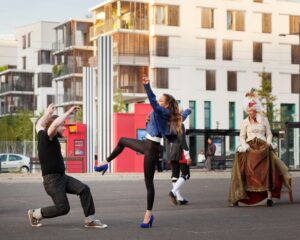
IY: Ironically, the backdrop of this world might be in fact the perfect given circumstances for the emergence and thriving of non-traditional and applied theatre. Do you see the purpose of Strike Anywhere as different today compared with the early 21st century?
LW: I think our fundamental purpose remains the same. However, the way we are proceeding is different. From 2001 to 2015, I would say that our work tended to launch off of specific issues. The rush to war and surge of nationalism post 9/11 inspired our show “10 Brecht Poems.” The deregulation and subsequent corporate consolidation of the media in 2003 prompted us to create the show “Spin.” Our 4-year investigation of fracking and its effects on communities from 2010 to 2014 resulted in our interview-based touring show “Same River.” During that 15-year period, our starting place for a new project often stemmed from a topical issue. However, now, with our latest project, “POP UP,” there is no underlying issue we are addressing, but rather we are exploring the whole concept of community and place. Pre-Trump, I think our purpose was to expose, incite and inspire action. Now, with the non-stop circus of daily egregious offenses, our approach has needed to shift. I sense an enormous amount of paralysis. The barrage of bad news is crippling. With “POP UP” we are investigating the hyperlocal; the show is about bringing people together, finding beauty and poetry in every day, in the streets. It’s a very different approach and one that I have had a hard time articulating because it is such a different way in for me and because it is a path that is unfurling as I step forward. We are partnering with a French company, the Tours Soundpainting Orchestra, on an interview-based show that explores a neighborhood. We interview people about the place. Those interviews inspire short performances that pop up all over the neighborhood. The show is set up as a treasure hunt – with the audience following clues that lead them to each new performance. We began working on it in 2015 and have been working with our two ensembles and a cartographer, Julien Rodriguez, to develop the piece for touring ever since. But this piece is a real departure for Strike Anywhere in terms of process and approach. I think that infusing joy, recognizing beauty in the quotidian, connecting to the local community is what it is about. My co-director, Angélique Cormier, likes to say that it’s about affirming the importance of poetry in the everyday. This would have all felt like fluff to me pre-Trump – but we are in such a different world now. People are isolated, catatonic, scared. I feel like my job is different. I am after a new approach, a sideways door that can inspire communal action through joy. I know that might sound lofty or potentially vacuous, but I think it is the radical approach we need now. Coming across a string trio at the bus stop, witnessing a clown in a heap of clothing at the laundromat, sweeping local residents into our “ephemeral choir” – these are some of the many moments we’ve crafted in our Soundpainted show “POP UP.”
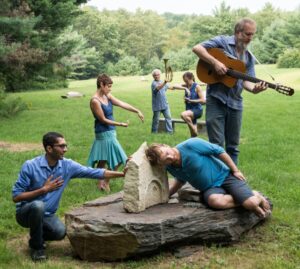
IY: You mentioned Soundpainting. One of the unique artistic skills that Strike Anywhere actors possess is the ability to soundpaint. Please explain what this unique artform entails.
LW: Soundpainting is a universal sign language for live [music] composition. The language comprises over 1,500 signed gestures that allow the Soundpainter to communicate with an orchestra of improvising performers. The language was invented by composer Walter Thompson in the 1970s and has expanded to include not only musicians but dancers, actors, and visual artists. It is now practiced in 35 countries. It is an amazing tool. It allows you to compose in real time. Picture an orchestra and a conductor. The relationship is visually similar in that the Soundpainter is communicating with the performers through gesture. However, in a traditional orchestra, the conductor is interpreting a written score. With Soundpainting, the Soundpainter is composing in the moment with a group of improvising performers. It’s a dialogue. I might sign to the trumpeter, “Improvise with a swing feel, watch me for the tempo,” and then I beat a specific tempo. I know a performer is going to play in that tempo and I know what genre she will improvise within, but the exact notes, what she plays, are up to her. I listen and respond. Soundpainting allows you to do things that were not previously possible in improvised works. We can create extremely sharp, nuanced works, make precise dynamic shifts, stops, and entrances with a large group thanks to the language. It’s a fabulous shortcut to create work with groups that may not have a long history together or to bring disparate groups together. I find it also useful to transcend perceived boundaries: ability, skill level, even language itself. Through Soundpainting, actors who don’t share the same spoken language can improvise together. I can teach the audience a few signs by demonstrating specific signs with the performers and then blast down the wall between audience and performer. I’ve used it to bring together different classes in school that don’t typically work together: the chorus, band and theatre club, or even mainstream students and special ed classes. It is a bridge, a way to unite groups.
I came across Soundpainting in the early ’90s. I met Walter [Thompson] during my first job in New York post-college. I was doing an internship at the Irondale Ensemble and he was the resident composer. He was using Soundpainting with his big band at that time. He had assembled some of the top downtown improvisers, and I was a huge fan of jazz and downtown music and was in awe. In 1997, when Walter decided he wanted to experiment with adapting the language for theatre, he asked me and another actor from Irondale, Josh Taylor, to help him figure out how the signs could be used with actors. So yeah, I was the first actress to be soundpainted! It’s funny now because we have these international thinktanks to discuss the language and the intricacies of how the signs work, and sometimes I just have to laugh because it all started so informally, a kind of basement project that just blew up and became something much bigger than I ever imagined.
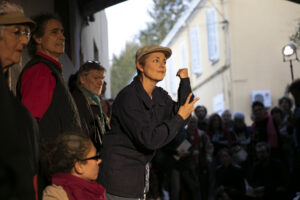
IY: Strike Anywhere was founded in 1997, more than 20 years ago. While improvisational methods and performance styles existed both then and now, did the emergence of such an unprecedented element as social media bring something unexpected into your work?
LW: I would say that it has brought new audiences to the work. We are able to expand our reach. I got an email from a high school friend who said she was talking to a colleague who mentioned Soundpainting. My friend mentioned me and Strike Anywhere. It turned out that her colleague was a huge fan, although she had never seen a live Strike Anywhere show or experienced one of our workshops. She was subscribed to Strike Anywhere’s social media channels and watched our videos religiously. This would have never been possible before the age of social media.
IY: Is there a show or a project that you have done that encompasses the essence of Strike Anywhere? How does it translate into your pedagogical methods and practices?
LW: The show that comes to mind is THE BOWIE PROJECT, a show about David Bowie, in which we are exploring the man behind the mask. We collaborated with Ariel Dance Theatre and the Super Creeps in Austin, Texas, and created a soundpainted mash-up of Bowie tunes and quotes from 1969–77. The improvisations dive off of known material into the intuitive. It’s wild and whacked out and a joy to perform. The Soundpainters are composing with fragments of song, taking movements and gestures, text from interviews and improvising within the containers of these tunes. We go all over the place. The show is really different every night.
We use the same creative process in the classroom as we do in the studio. It’s an interdisciplinary, inquiry-based approach. I function as the facilitator and set an experiment in motion for the group to creatively problem-solve. It’s a non-hierarchical ensemble process. The term applied theatre came about years after we were doing it, but I think that is how most theatre-makers would understand our pedagogical practice. We use experiential teaching methods. The content can be anything – we design the delivery system. Roleplay, improv, theatre games, playwriting, text analysis – the techniques are applied to illuminate the content. We have a wide range of educational programmings, such as project-based residencies, animating classroom curriculum, professional development programs, Soundpainting master classes, language acquisition for ELL students, student-centered devising residencies. . . . We do a lot of different things. Education has been a real passion of mine, and I have worked for more than a dozen of New York City’s top cultural institutions crafting education programs, curricula and exploring best practices. Strike Anywhere now has Amanda Hinkle Wallace as our Director of Education and Partnerships. We are so lucky! She brings close to 20 years of experience and relationships to her work. I met her when she worked for Roundabout. She then went on to serve as Director of Education at Irondale for 7 years working with SA on a project basis over the last decade, but now she is on staff. Such a gift!
I think the SAME RIVER at JKO is one of the most successful [educational] projects to date. This was a residency that just caught fire in the school. Originally slated to connect one science class and an art class, the students got so into it and word of the project spread throughout the school that we had both teachers and students approach us about how they could get involved. And get this . . . the show was about fracking! The kids didn’t even know what it was when we arrived. But once they started conducting interviews and learning about the potential threat to New York City’s water supply, they got fired up! We have a video that really captures the excitement of what happened. Students mirrored the creative process that SA used to create the show SAME RIVER and created their own version of the show. By the time the students opened the show, the entire science department, the film class, an English class, and the dance department got involved. It was amazing. But what happened to the students, going from being completely oblivious about the issue to being passionately engaged in alerting their friends and families about it, stunned me and directly mirrored our ensemble’s own experience.
IY: Strike Anywhere is based in New York City. Have you been successful in expanding across state lines?
LW: We did that a long time ago! From 2003 to 2008, we toured to over 50 venues in over a dozen states. In 2007, we started to work internationally. The last few years we have worked overseas quite a bit. Honestly, I got sick of producing work in New York. It’s so expensive and exhausting. I much prefer touring. I feel that as we mature, we are growing into our name. Between the creative place-making, the site-specific work, the improv and all the touring – we really do Strike Anywhere!
IY: What can you share about current or upcoming projects you are working on?
LW: Currently we are working on two projects. This month, we are co-producing the 2019 LIVE COMPOSITION FESTIVAL in Gowanus, Brooklyn. It’s going to be a happening! The 2-day festival will feature 6 different interdisciplinary ensembles that employ various sign languages to compose in real time. Drummer BILLY MARTIN, of the avant-groove band Medeski Martin and Wood, will kick off the festival, and it will highlight three of the top Soundpainting groups in the U.S.: Letter of Marque, the Walter Thompson Orchestra and Strike Anywhere. Human Time Machine is playing (percussion group), and there will be a live video projectionist, JONATHAN CHECLER, and live painting by cartoonist/illustrator SAM FERRI (MAD Magazine, New York Observer). It should be a real scene. It’s at the Gemini and Scorpio Loft, which really feels like stepping back in time – like New York City in the early ’90s – funky, gritty, experimental. I’m pretty excited about the festival. Walter is coming from Sweden. He is going to offer a 2-day intensive for experienced Soundpainters. It’s the first time he has taught in the States in over 10 years.
The second project we have coming up is the U.S. premiere of POP UP on October 4–6, 2019, in Fort Greene, Brooklyn. This is our collaboration with the Tours Soundpainting Orchestra from France. My collaborators co-director Angélique Cormier and the cartographer Julien Rodriguez just left town. We completed the interviews in Fort Greene last week and Julien mapped the neighborhood. We scoped out potential performance sites. The show is set up as an artistic treasure hunt. The public is guided to a series of 15 to 20 site-specific performances via clues on a hand-painted map. Over the course of 2 to 3 days, performances pop up on the street, in windows, parks, plazas, and businesses throughout one neighborhood. These short apparitions of music, dance, theatre and/or visual art are inspired by interviews with local residents and business owners about that neighborhood.
By injecting a series of alternately playful, poetic or poignant performances in everyday spaces, the project is designed to shift how people perceive those places and to connect community members through art. The performances are sculpted through Soundpainting. There is a series of wrap-around events that allow community members to come together and to engage with the project. One of the ways is through interviews, another through free Soundpainting workshops which then allow us to invite community members and local arts groups into the key scenes. This is creative place-making. The show is by, for, with and about the local people. We are working with Irondale, who is the local partner. They have deep ties in the neighborhood, and we are working with a web of community partners to ensure wide participation among residents.
This post was written by the author in their personal capacity.The opinions expressed in this article are the author’s own and do not reflect the view of The Theatre Times, their staff or collaborators.
This post was written by Irina Yakubovskaya.
The views expressed here belong to the author and do not necessarily reflect our views and opinions.

